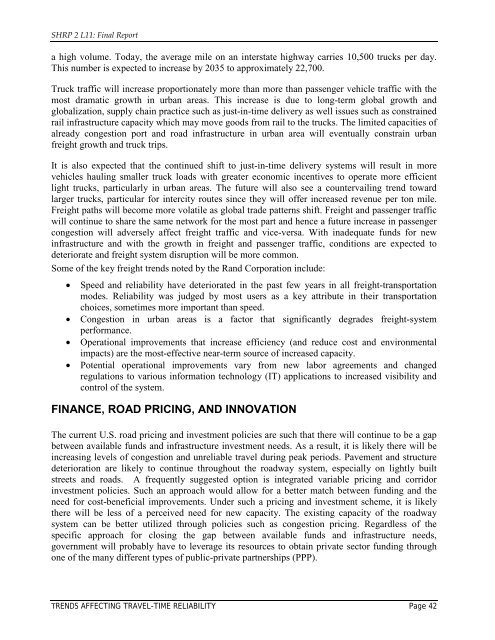Evaluating Alternative Operations Strategies to Improve Travel Time ...
Evaluating Alternative Operations Strategies to Improve Travel Time ...
Evaluating Alternative Operations Strategies to Improve Travel Time ...
You also want an ePaper? Increase the reach of your titles
YUMPU automatically turns print PDFs into web optimized ePapers that Google loves.
SHRP 2 L11: Final Report<br />
a high volume. Today, the average mile on an interstate highway carries 10,500 trucks per day.<br />
This number is expected <strong>to</strong> increase by 2035 <strong>to</strong> approximately 22,700.<br />
Truck traffic will increase proportionately more than more than passenger vehicle traffic with the<br />
most dramatic growth in urban areas. This increase is due <strong>to</strong> long-term global growth and<br />
globalization, supply chain practice such as just-in-time delivery as well issues such as constrained<br />
rail infrastructure capacity which may move goods from rail <strong>to</strong> the trucks. The limited capacities of<br />
already congestion port and road infrastructure in urban area will eventually constrain urban<br />
freight growth and truck trips.<br />
It is also expected that the continued shift <strong>to</strong> just-in-time delivery systems will result in more<br />
vehicles hauling smaller truck loads with greater economic incentives <strong>to</strong> operate more efficient<br />
light trucks, particularly in urban areas. The future will also see a countervailing trend <strong>to</strong>ward<br />
larger trucks, particular for intercity routes since they will offer increased revenue per <strong>to</strong>n mile.<br />
Freight paths will become more volatile as global trade patterns shift. Freight and passenger traffic<br />
will continue <strong>to</strong> share the same network for the most part and hence a future increase in passenger<br />
congestion will adversely affect freight traffic and vice-versa. With inadequate funds for new<br />
infrastructure and with the growth in freight and passenger traffic, conditions are expected <strong>to</strong><br />
deteriorate and freight system disruption will be more common.<br />
Some of the key freight trends noted by the Rand Corporation include:<br />
• Speed and reliability have deteriorated in the past few years in all freight-transportation<br />
modes. Reliability was judged by most users as a key attribute in their transportation<br />
choices, sometimes more important than speed.<br />
• Congestion in urban areas is a fac<strong>to</strong>r that significantly degrades freight-system<br />
performance.<br />
• Operational improvements that increase efficiency (and reduce cost and environmental<br />
impacts) are the most-effective near-term source of increased capacity.<br />
• Potential operational improvements vary from new labor agreements and changed<br />
regulations <strong>to</strong> various information technology (IT) applications <strong>to</strong> increased visibility and<br />
control of the system.<br />
FINANCE, ROAD PRICING, AND INNOVATION<br />
The current U.S. road pricing and investment policies are such that there will continue <strong>to</strong> be a gap<br />
between available funds and infrastructure investment needs. As a result, it is likely there will be<br />
increasing levels of congestion and unreliable travel during peak periods. Pavement and structure<br />
deterioration are likely <strong>to</strong> continue throughout the roadway system, especially on lightly built<br />
streets and roads. A frequently suggested option is integrated variable pricing and corridor<br />
investment policies. Such an approach would allow for a better match between funding and the<br />
need for cost-beneficial improvements. Under such a pricing and investment scheme, it is likely<br />
there will be less of a perceived need for new capacity. The existing capacity of the roadway<br />
system can be better utilized through policies such as congestion pricing. Regardless of the<br />
specific approach for closing the gap between available funds and infrastructure needs,<br />
government will probably have <strong>to</strong> leverage its resources <strong>to</strong> obtain private sec<strong>to</strong>r funding through<br />
one of the many different types of public-private partnerships (PPP).<br />
TRENDS AFFECTING TRAVEL-TIME RELIABILITY Page 42















